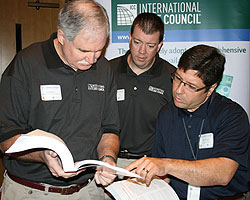
Rebuilding Process
 |
|
Code Council staff members John Battles (left) and Jeff Walker (center) discuss wind load provisions in the 2012 International Building Code with FEMA Building Sciences Branch Senior Engineer Joe Ingargiola during the Safer Alabama Summit in Tuscaloosa. |
While performing more than 44,200 structural inspections following the April 27 tornadoes, AEMA Director Art Faulkner said officials determined two key elements would be necessary for Alabama to rebuild smarter, safer and stronger: (1) While new school construction includes safe areas as prescribed in ICC 500: Standard for the Design and Construction of Storm Shelters and other standards, existing school buildings should be hardened to those standards; and (2) The use of the Federal Emergency Management Agency's (FEMA) hazard mitigation grant program should be encouraged to construct residential safe rooms and community storm shelters.
Phil Campbell, Alabama, Mayor Jerry Mays told attendees he has first-hand proof that disaster mitigation saves lives—he was one of 60 residents who took refuge in the community's storm shelter on April 27 as an EF5 tornado bore down on the town of 1,100. The storm destroyed 410 structures in Phil Campbell and 27 lives were lost. "Thank God for the 60 people who were in it," Mays said. "Our shelter was well tested and it came out unscathed. We just need more of them."
Dr. Ernst Kiesling, Executive Director of the National Storm Shelter Association, which co-developed ICC 500 with the Code Council, discussed the history of storm shelter and safe room science over the past 40-plus years and outlined some of the quality issues that should be addressed in their design and construction: untested door systems, improper anchors, and inadequate numbers of doors and hatches. FEMA Federal Disaster Recovery Coordinator Albie Lewis added that improper door systems are most commonly found in residential safe rooms. "Doors are a critical area," Lewis said. "No wooden door has ever passed an impact test."
Kiesling and FEMA Building Sciences Branch Senior Engineer Joe Ingargiola said jurisdictions also should update to the latest building codes as means to mitigate future disasters. Lewis said inspection teams discovered that both newer and older buildings suffered extensive damages during the April 27 tornadoes, although newer construction models had much better performances in inflow areas. "Buildings designed to recent codes verified that newer code requirements improved performance," he said.
The Safer Alabama Summit brought together federal, state and local officials as well as architects and contractors at the University of Alabama in Tuscaloosa to discuss lessons learned from the tornadoes and to examine safer, stronger and smarter structures. On April 27, 64 tornadoes were on the ground in Alabama for 640 miles, claiming 241 deaths with an estimated $100 million in damages.
Alabama Governor Robert Bentley encouraged attendees to look for innovative ideas to mitigate future disasters, including hardening existing school facilities that can double as shelters in the state that also is prone to other disasters such as hurricanes. "If we have a set amount of money available to us, we have to make sure that money is spent in the best way possible to protect the largest number of people," Bentley said. "We need to make sure (citizens) are safe, and if we have safer places for them to be then that's where they need to be."